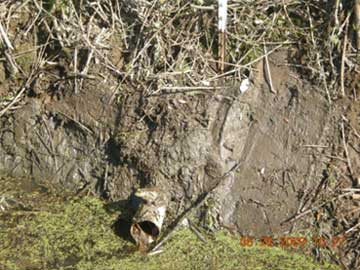Sediment deposition is one of the most common impacts to agricultural drainage. The Agricultural Drainage Assistance Program (ADAP) has developed a manual of best management practices (BMPs) (12.2 MB) for addressing these impacts.

Exposed field tiles after sediment removal
Sediment is a problem for clean water, salmon and humans. It is also a problem for agriculture when is fills drainages and waterways. The source? Soil and rocks that washes down hills and streams or is left by river flows in floodplains.
Soil that washes down hills and streams, also called alluvial deposits, fills stream bottoms and raises the level of water in the stream. Raising the stream bottom also raises the groundwater level under the fields near the stream. This is obvious where field tiles, or pipes are used to drain soil and the soil covers the outlets.
Flooding also adds sediment that often includes fine grain silts and clays. These fine sediments take longer to buildup because only a little sediment is left behind with each flood.

 Translate
Translate